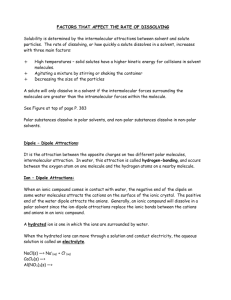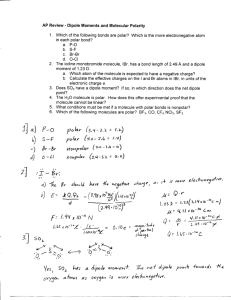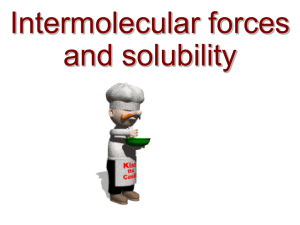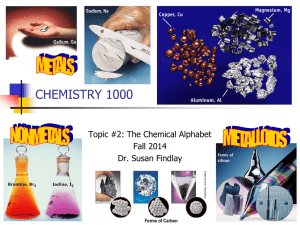Bellwork - Cloudfront.net
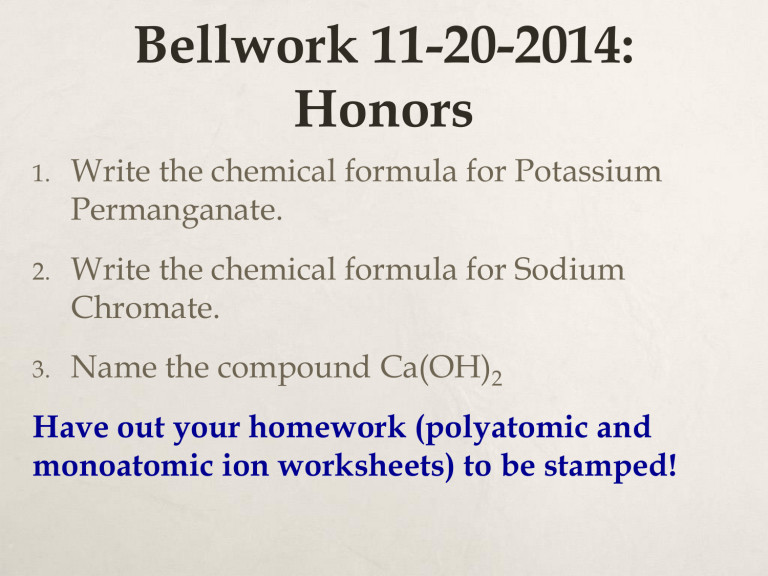
1.
Bellwork 11-20-2014:
Honors
Write the chemical formula for Potassium
Permanganate.
2.
Write the chemical formula for Sodium
Chromate.
3.
Name the compound Ca(OH)
2
Have out your homework (polyatomic and monoatomic ion worksheets) to be stamped!
Announcements: Honors
Deadlines:
Summative writing assignment: today after school
Turn in lab for late grade: today after school
Tutoring moved to TODAY
**Element
**Compound
**Diatomic Element
Vocab Cards!
Octet
Outer shell
Polar covalent bond
Lewis dot structure
Valence electrons
Dissociation
Solubility
Electronegativity
Non-polar covalent bond
Ionic bond
Electrical conductivity
Cation
Anion
Vocab Smash Game Rules
You cannot start FAST WALKING until I have read the question completely
NO RUNNING OR PUSHING!
Teammates: DO NOT YELL OUT THE ANSWER!
Each correct hit = 1 point
If there is a tie: the face off will be correctly writing the chemical formula for an ionic compound
Cool Videos
https://www.youtube.com/watch?v=ASLUY2U1M-
8&list=PLA97087254E575992&index=4
Bellwork 11-25-2014
1.
2.
3.
4.
Have out homework on writing and naming ionic compounds to be checked!
Have out lab notebook: I will check ionic vs. covalent bonding lab and ionic bonding puzzle lab (EVERYONE!)
Write the chemical formula for Lead (III) oxide using the crisscross method
Name the compound: MgO using the rules from your note-taker
Announcements
Go over homework
If you did not show me your labs today, I need to see them by tomorrow!
1.
2.
3.
4.
5.
Writing and Naming Ionic
Compounds HW
Writing: Naming:
CaBr
2
BaO
K
2
S
LiF
6. Ca
8. Be
3
3
P
N
7. MgCl
2
2
9. Fe
2
O
3
2
Na
3
N 10. CuBr
2
1. Sodium Sulfide
2. Potassium Chloride
3. Calcium Sulfide
4. Lithium Oxide
5. Beryllium Nitride
Where are we?
Intramolecular forces Intermolecular forces
Between elements
Lewis structures of single elements and molecule bonds
Between molecules
Lewis structures of molecules (interactions)
Ionic
Anion Cation
Covalent
Polar Non-polar
Molecular shapes
Dipole-dipole
Hydrogen
London dispersion
Ion-dipole
Polarity
Intermolecular Forces:
Exploration
Read the first part of your note-taker and
INDEPENDENTLY write down in the think column (2 min)
Share with your neighbor and write down any additional observations they made that you did not (2 min)
Share with the class and write down any additional observations that others in the class cam up with (3 min)
Quiz
Explain how ionic bonds are formed using cations, anions, charge (+/-) and give an example.
Intermolecular Forces:
Exploration
We will come back to this substance and figure out what it is later!!
Intermolecular Forces
So far we have been looking at bonds and the forces that hold elements together in a compound
What were these forces?
Now we will look at INTER molecular forces: the forces that hold 2 or more different compounds or molecules together.
Type 1: Dipole-Dipole
Dipole Moment: the charge distribution in a polar bond caused by differences in electronegativities between atoms in the bond
Shown using a vector: the
Head of the arrow is
δ end, butt of the arrow is the δ + end
Video – dipole-dipole
https://www.youtube.com/watch?v=cERb
1d6J4-M
Dipole-Dipole Interaction
The attraction of one molecules dipole for the opposite dipole on another molecule
H Cl
H Cl
Type 2: Hydrogen
Interaction
More specific dipole-dipole interaction
H-interaction:
The interaction of hydrogen’s dipole with opposite dipole on a O, N or F atom ONLY
Water Demos
Why does the soap make the cinnamon scatter?
Soap Molecule
Type 3: London Dispersion
Force
Forces between 2 molecules that are nonpolar or have no dipole moment
Attraction of p+ of one molecule for the eon another molecule
This creates a temporary dipole on each molecule, which interact oppositely https://www.youtube.com/watch?v=1iYKaj
MsYPY
Honors – Type 4: Ion-
Dipole Interaction
The interaction of a fully charged ion in solution with the oppositely charged dipole of the molecule making up the solution.
Predict: what would happen if you put NaCl in water? How would the resulting solution look after you mixed it?
Non Newtonian Fluid
Molecular Shape and
Polarity
Because all molecules take on different molecular shapes, some molecules may contain polar bonds and ultimately be polar
OR non-polar molecules.
Draw each example with its electron pair and molecular geometry to determine if the molecule is overall polar or non-polar
Name the interaction!
Hydrogen interaction
Name the interaction!
London Dispersion
Name the interaction!
Dipole-dipole
Homework
Worksheet on drawing intermolecular forces
DUE: Mon/Tue Dec. 1/2


